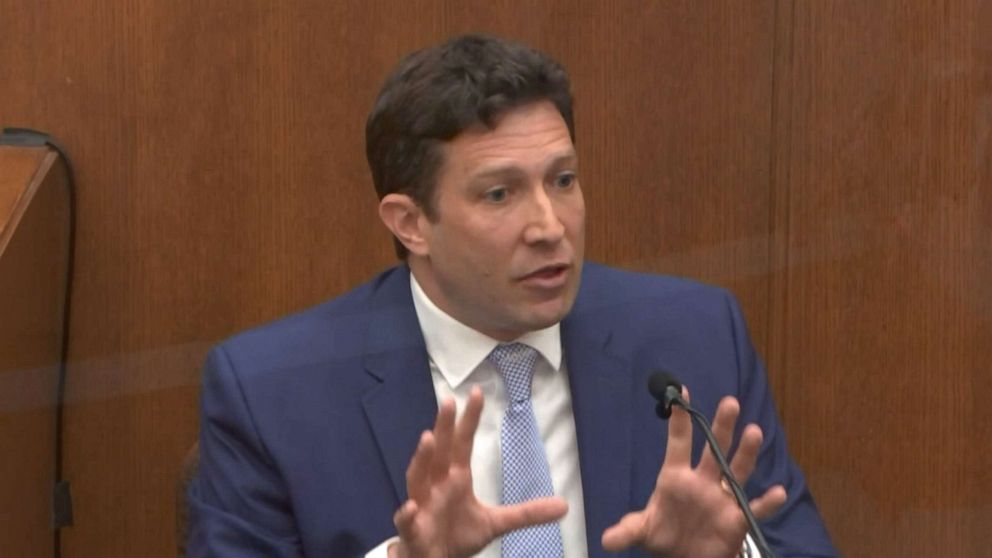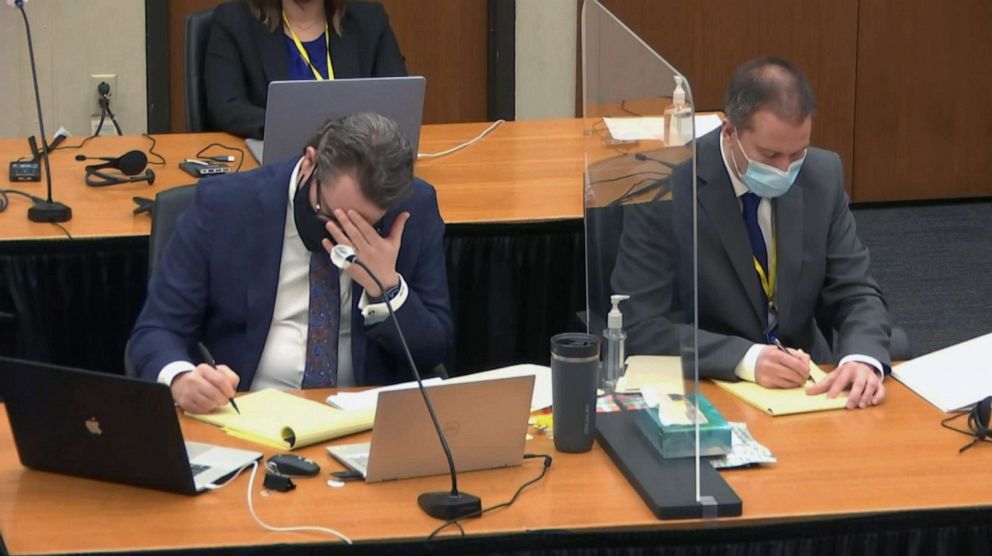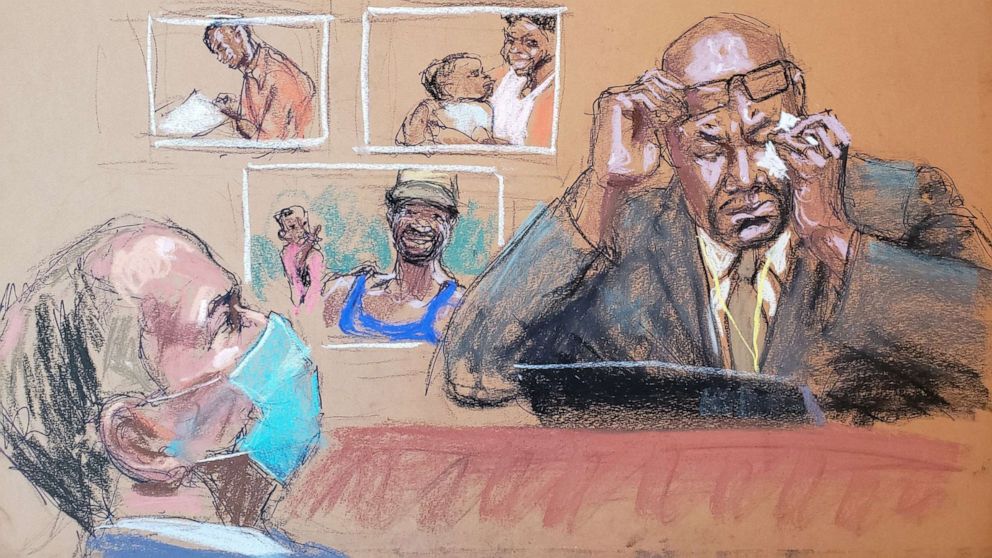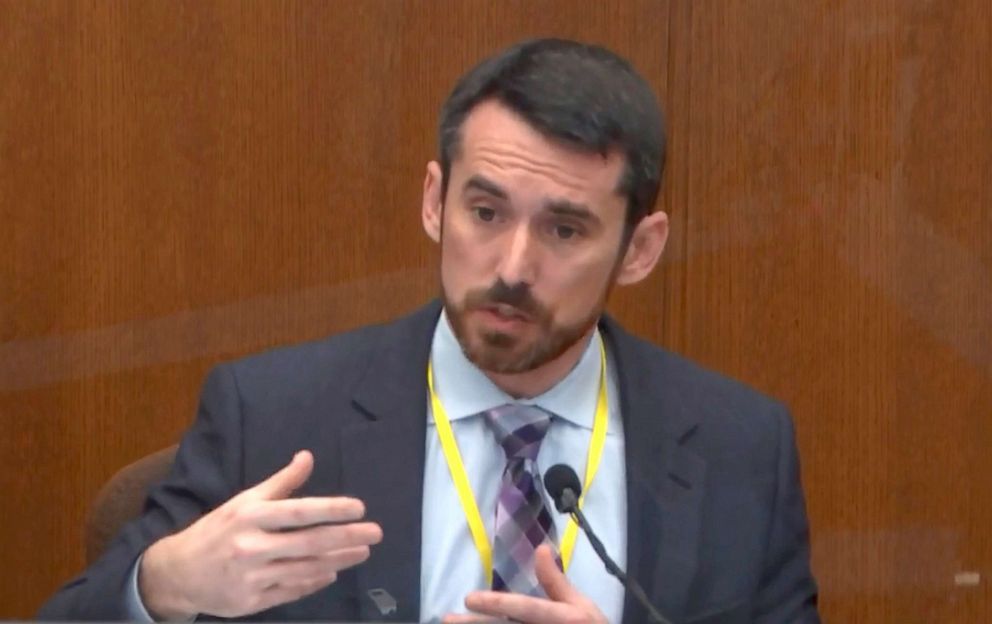起诉方在谋杀案审判主持审判的法官告诉陪审员,前明尼阿波利斯警官德里克·肖万的案子预计将于星期二休庭。
亨内平县地方法院法官彼得·卡希尔在结束周一的刑事诉讼时通知陪审团,肖万的律师将开始传唤辩方证人,并表示审判的证据部分最早可能在周四结束。
卡希尔说,如果辩护在周四结束,他将在周一安排结案陈词。他建议陪审员,一旦他们收到案件,他们将在评议期间被隔离在一家酒店。
“我倾向于给律师更多的时间准备结案陈词,我们预计在周一进行结案陈词,”卡西尔说。“预计当你周一报到时,将会被扣押。所以,装个包。”
医学专家称弗洛伊德死于窒息
乔纳森·里奇博士是芝加哥北方纪念医院的心脏病专家,也是西北大学的医学副教授,他是周一作为起诉的医学专家被传唤作证的第一个证人。他说这是他第一次在法庭上作证。
“明尼苏达州联系了我,作为一名心脏病专家,我被问及是否可以回顾一下这个案件的事实,以帮助确定乔治·弗洛伊德先生是如何死亡的,”里奇谈到他为什么被叫到证人席上时说。

通过美国广播公司新闻的法庭电视
心脏病专家乔纳森·里奇博士在前警官德里克·肖万的审判中作证
他说,他审查了弗洛伊德的尸检报告、导致他死亡的三年医疗记录、警方的身体摄像头视频、监控摄像头和旁观者手机摄像头的镜头,以确定弗洛伊德的死因。
检察官杰里·布莱克威尔要求里奇告诉陪审团他对弗洛伊德死因的“高度医学确定性”的看法。
“在这种情况下,乔治·弗洛伊德先生死于心肺骤停。这是由低氧水平引起的,低氧水平是由他受到的俯卧约束和体位窒息引起的,”里奇作证说。
他的意见与其他检方医学证人所说的一致,包括周五对弗洛伊德进行尸检的亨内平县法医安德鲁·贝克医生的意见。
贝克作证说,弗洛伊德死于“心肺骤停,使执法制服、约束和颈部压迫复杂化”,这意味着他在地面上受到约束时,他的心脏和肺停止了工作。他裁定这起死亡是他杀。
法医还证实,在弗洛伊德的系统中发现的药物、芬太尼和甲基苯丙胺,以及未确诊的使心脏主要动脉变窄的心脏病,都是导致他死亡的因素。
贝克说:“考虑到他潜在的心脏病和毒物学状态,正是与警方互动的压力使他处于危险之中。”。
在审判的开场陈述中,肖万的律师埃里克·尼尔森告诉陪审团,证据将显示弗洛伊德死于过量药物导致的突发心脏病,而肖万的膝盖在他脖子上的时间(检方称是9分29秒)并没有导致他死亡。
“弗洛伊德先生是逐渐死亡的。这不会被认为是典型的猝死...也就是说,当人们出现心室纤维性颤动时,他们确实会从一瞬间的良好状态到下一瞬间的完全消失。
他说,他没有发现弗洛伊德死于冠状动脉阻塞引起的突发心脏病的证据,并解释说,在他审查的大量证据中,他没有发现这种迹象,例如一块血小板完全阻塞了一条动脉。
里奇是一名付费的检方证人,他说他发现弗洛伊德系统中的药物水平如此之低,以至于不可能杀死一个对药物有耐药性的人,而弗洛伊德是一个长期使用者。
他指出,弗洛伊德2018年的医疗记录显示,他曾出现在急诊室,并告诉医生,他在两个小时内服用了八粒Percocet药丸,这是一种含有羟考酮的阿片类止痛药,医院工作人员只是在释放他之前观察了他。
他说弗洛伊德的死是“完全可以预防的”,并指出有几次警官可以把他翻过来帮助他呼吸,并开始急救,这可能会挽救他的生命,包括有一次他听到一名警官在视频中告诉肖万,“我想他晕过去了。”
布莱克威尔问里奇,“如果不是肖万先生在地面上压制和克制了乔治·弗洛伊德9分29秒,你认为他会活下来吗?”
里奇回答说:“是的,我相信他会活着。”

通过美国广播公司新闻的法庭电视
辩护律师埃里克·尼尔森(左)和被告、前明尼阿波利斯警官德里克·查
在尼尔森的交叉检查中,里奇承认右冠状动脉阻塞90%和左前降支阻塞75%的人死于突发心脏病。
尼尔森重复了布莱克威尔关于弗洛伊德的死是否可以预防的问题,问道,“那么,换句话说,如果他进了警车,他会活着吗?”
弗洛伊德的哥哥作证
弗洛伊德的哥哥,菲洛尼斯·弗洛伊德39岁,在证人席上向陪审团提供了在明尼苏达州被称为“生命火花主义”的证词。
源于1985年州最高法院的一个案件,明尼苏达州在判决前很少允许被指控的犯罪受害者的亲人提供这种个人的、往往是情绪化的证词。在大多数州,如果定罪,这种证词只用于量刑时对受害者的影响陈述。
菲洛尼斯·弗洛伊德描述了他哥哥在北卡罗来纳州费耶特维尔和休斯顿康尼之家公共住房项目中的成长经历。他描述了他哥哥对任天堂视频游戏的喜爱,他在高中和大学打篮球和足球的能力,以及他对他们已故母亲拉塞尼亚·弗洛伊德的爱。
他称他的哥哥为“肥妈的儿子”,他和2018年去世的母亲有着特殊的关系。
“在他身边,他向我们展示了如何对待我们的妈妈,如何尊重我们的妈妈,”菲洛尼斯·弗洛伊德作证说。

简·罗森伯格通过路透 在三月十一日回答问题时谈到了他的哥哥
他说,当他们的母亲于2018年5月去世时,乔治·弗洛伊德(George Floyd)情绪崩溃,因为他在明尼苏达州,而不是在休斯顿与她在一起。
“所以,那件事对他伤害很大。当我们去参加葬礼时,乔治只是坐在棺材旁...他只会一遍又一遍地说‘妈妈,妈妈’。”他说,回忆起他哥哥在肖万的膝盖压在他脖子上快要死的时候重复的同样的哭声。
“我不知道该告诉他什么,因为我也很痛苦,”他说。“我们都很受伤,他只是吻她,吻她。他不想离开棺材。”
“不可接受或合理使用武力”
检方当天打电话给国家警察使用武力专家、南卡罗来纳大学法学院助理教授塞思·斯托顿(Seth Stoughton)。
付费控方证人斯托顿说,他花了140多个小时研究了大约4万页的案件文件,查看了大量视频,包括警方的人体摄像头和旁观者的手机镜头。
“在这种情况下,与我参与的绝大多数案件不同,有一大堆视频,”他说,并补充说,同一事件视频的不同前景使他“对正在发生的事情有了更深入的了解。”
斯托顿说,弗洛伊德忍受的武力只有在他被从警车上带走的时候才是合理的,因为这个已经戴着手铐的人拒绝进去。
但是,一旦肖万和其他警官把他从警车上带走,并把他放在人行道上,让他跪下,斯托顿说,这就是武力应该停止的地方,因为弗洛伊德不再反抗,甚至感谢警官在他告诉他们他有幽闭恐惧症后把他从车上带走。

美联社法庭电视
南卡罗来纳大学法学教授塞思·斯托顿在对前者的审判中作证.
佛罗里达州塔拉哈西市前警官斯托顿说,然而,警官们继续将弗洛伊德俯卧在人行道上,肖万将他的左膝放在弗洛伊德的脖子后面,保持9分29秒,这位46岁的黑人男子27次哭喊他无法呼吸,为他的母亲哭喊,最终陷入沉默,失去知觉和脉搏。
斯托顿说:“考虑到官员们可以选择的其他选择范围,让在这一点上合作的人屈服是不合适的。”。
当检察官史蒂夫·施莱歇尔(Steve Schleicher)问及一名训练有素的警官是否认为对弗洛伊德使用武力是合理的时,斯托顿不同意。
斯托顿说:“弗洛伊德先生脖子上的膝盖和俯卧式约束都是不合理的、过度的,违反了普遍接受的警察惯例。”。
他说,弗洛伊德在俯卧位被压住的整个过程中,都被施加了不合理的力量。
斯托顿说:“没有一个通情达理的官员会相信这是一种适当的、可接受的、合理的武力使用。
Key takeaways from the Derek Chauvin murder trial, Day 11
The prosecution in themurder trialof former Minneapolis police officer Derek Chauvin is expected to rest its case on Tuesday, the judge presiding over the trial told jurors.
Hennepin County District Court Judge Peter Cahill concluded Monday's criminal proceedings by informing the jury that Chauvin's attorney will begin calling defense witnesses and said the evidence portion of the trial could end as early as Thursday.
Cahill said that if the defense finishes on Thursday, he will schedule closing arguments on Monday. He advised jurors that once they receive the case, they will be sequestered in a hotel for the duration of the deliberations.
"My preference is to give the attorneys more time to prepare their closing arguments and have the closing arguments, we predict, on Monday," Cahill said. "Expect that when you report to duty on Monday it will be followed by sequestration. So, pack a bag."
Medical expert says Floyd died of asphyxia
Dr. Jonathan Rich, a cardiologist at Northern Memorial Hospital in Chicago and an associate professor of medicine at Northwestern University, was the first witness called to testify on Monday as a medical expert for the prosecution. He said it was the first time he had ever testified in court.
"I was contacted by the state of Minnesota, and I was asked as a cardiologist if I could review the facts of this case to help determine how Mr. George Floyd died," Rich said of why he was called to the witness stand.
He said he reviewed the autopsy report on Floyd, three years of medical records leading to his death, and police body-camera videos, footage from surveillance cameras and bystander cellphone cameras to determine what killed Floyd.
Rich was asked by prosecutor Jerry Blackwell to tell the jury his opinion to a "high degree of medical certainty" the cause of Floyd's death.
"In this case, Mr. George Floyd died from a cardiopulmonary arrest. It was caused by low oxygen levels, and those low oxygen levels were induced by the prone-restraint and positional asphyxiation that he was subjected to," Rich testified.
His opinion echoed what other prosecution medical witnesses have said, including the opinion given on Friday from Dr. Andrew Baker, the Hennepin County medical examiner who performed the autopsy on Floyd.
Baker testified that Floyd died of "cardiopulmonary arrest, complicating law enforcement subdual, restraint, and neck compression," meaning that his heart and lungs stopped working as he was being restrained on the ground. He ruled the death a homicide.
The medical examiner also testified that drugs found in Floyd's system, fentanyl and methamphetamine, as well as undiagnosed heart disease that narrowed the essential arteries to the heart, were contributing factors to his death.
"It was the stress of that interaction (with police) that tipped him over the edge given his underlying heart disease and toxicological status," Baker said.
In his opening statement in the trial, Chauvin's attorney, Eric Nelson, told the jury that evidence will show Floyd died from a sudden heart attack brought on by an overdose of drugs and that Chauvin's knee on his neck for what prosecutors said was 9 minutes and 29 seconds did not cause his death.
"Mr. Floyd died a gradual death. It would not be considered a classic sudden death ... meaning when people have that ventricular fibrillation, they literally go from being fine one moment to completely out the next," Rich said.
He said he found no evidence that Floyd died from a sudden heart attack due to a blockage of his coronary arteries, explaining he found no tell-tale signs of that in the voluminous evidence he reviewed such as a piece of plaque platelets completely clogging an artery.
Rich, a paid prosecution witness, said he found that the drugs in Floyd's system were at such low levels they could not have killed someone with the type of tolerance to drugs that Floyd had built up as a chronic user.
He noted that Floyd's medical records dating back to 2018 showed he once showed up at an emergency room and told doctors he had consumed eight Percocet pills, an opioid pain reliever containing oxycodone, over a two-hour period and the hospital staff simply observed him before releasing him.
He said Floyd's death was "absolutely preventable" and noted several times when officers could have turned him on his side to help him breathe and started first aid that would have likely saved his life, including a moment he heard one of the officers on video telling Chauvin, "I think he's passing out."
Blackwell asked Rich, "Do you have an opinion as to whether George Floyd would have lived if not for Mr. Chauvin's subdual and restraint of him for 9 minutes and 29 seconds on the ground?"
Rich replied, "Yes, I believe he would have lived."
During cross-examination from Nelson, Rich conceded that people with 90% blockage of the right coronary artery and a 75% blockage of the left anterior descending artery have died from a sudden heart attack.
Echoing Blackwell's questioning on whether Floyd's death was preventable, Nelson asked, "So, in other words, if he had gotten in the squad car, he'd be alive?"
Floyd's brother testifies
Floyd's brother,Philonise Floyd, 39, took the witness stand to provide the jury with what is known in Minnesota as "spark of life doctrine" testimony.
Stemming from a 1985 state Supreme Court case, Minnesota is rare in permitting such personal and often emotional testimony from loved ones of an alleged crime victim in advance of a verdict. In most states, such testimony is reserved for victim impact statements during sentencing if there is a conviction.
Philonise Floyd described his brother's upbringing in Fayetteville, North Carolina, and at the Cuney Homes public housing project in Houston. He described his brother's fondness for Nintendo video games, his prowess in playing basketball and football in high school and college, and his love for their late mother, Larcenia Floyd.
He called his brother a "big momma's boy," who had a special relationship with their mother, who died in 2018.
"Being around him, he showed us like how to treat our mom and how to respect our mom," Philonise Floyd testified.
He said that when their mother died in May 2018, George Floyd was emotionally crushed that he was in Minnesota and not at her side in Houston.
"So, that right there it hurt him a lot. When we went to the funeral, George just sat there at the casket ... and he would just say 'momma, momma' over and over again," he said, recalling the same cries his brother repeated as he was dying under the weight of Chauvin's knee on his neck.
"I didn't know what to tell him because I was in pain, too," he said. "We all were hurting and he was just kissing her and kissing her. He did not want to leave the casket."
'Unacceptable or reasonable use of force'
The prosecution ended the day by calling Seth Stoughton, a national police use-of-force expert and an assistant professor at the University of South Carolina School of Law.
Stoughton, a paid prosecution witness, said he has spent more than 140 hours studying roughly 40,000 pages of documents in the case and reviewing numerous videos, including police body-camera and bystander cellphone footage.
"In this case, unlike the vast majority of cases that I've been involved in, there were a whole bunch of videos," he said, adding that the different prospectives of video of the same event allowed him a "much more robust understanding of what was going on."
Stoughton said the use of force Floyd endured was only justified up to the point he was removed from a police car because the already handcuffed man was resisting getting inside.
But once Chauvin and the other officers removed him from the squad car and placed him on the pavement on his knees, Stoughton said that's where the use of force should have ended because Floyd was no longer resisting and even thanked the officer for removing him from the car after he informed them he was claustrophobic.
The officers, however, proceeded to place Floyd in a prone position on the pavement and Chauvin placed his left knee on the back of Floyd's neck, keeping it there for 9 minutes and 29 seconds as the 46-year-old Black man cried out 27 times that he could not breathe, cried out for his mother and eventually went silent, lost consciousness and a pulse, said Stoughton, a former Tallahassee, Florida, police officer.
"Given the range of other alternatives available to the officers, it's just not appropriate to prone someone who is at that point cooperative," Stoughton said.
Asked by prosecutor Steve Schleicher if a trained police officer could view the force used on Floyd as reasonable, Stoughton disagreed.
"Both the knee across Mr. Floyd's neck and the prone restraint were unreasonable, excessive and contrary to generally accepted police practice," Stoughton said.
He said unreasonable force was used on Floyd the entire time he was being held down in the prone position.
"No reasonable officer," Stoughton said, "would have believed that that was an appropriate, acceptable and reasonable use of force."






